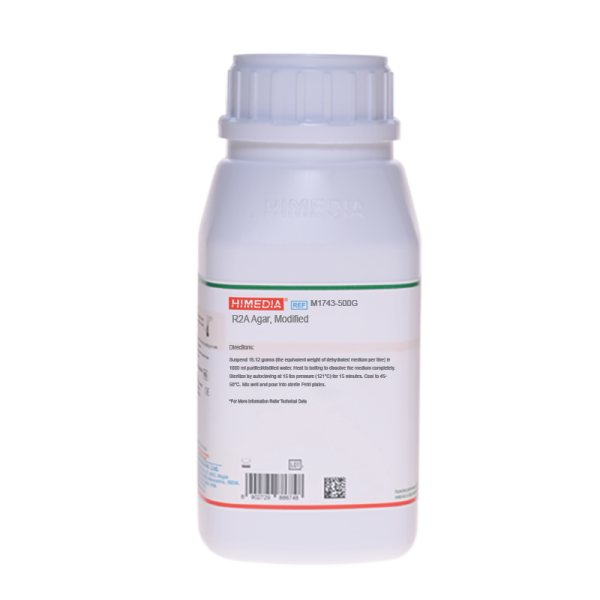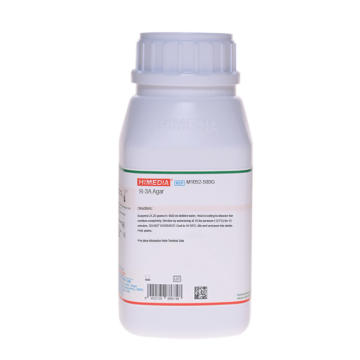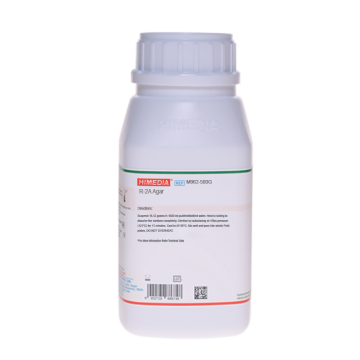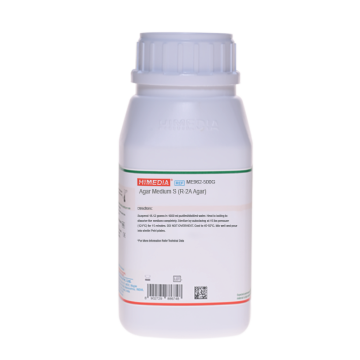 Your enquiry has been submitted
Your enquiry has been submitted
R2A Agar, Modified
This medium is recommended for the enumeration and cultivation of bacteria from potable water.
Composition**
| Ingredients | Gms / Litre |
|---|---|
| Casein Enzymic hydrolysate | 0.250 |
| Peptic digest of animal tissue | 0.250 |
| Casein Acid hydrolysate | 0.500 |
| Yeast extract | 0.500 |
| Glucose | 0.500 |
| Starch soluble | 0.500 |
| Dipotassium phosphate | 0.030 |
| Magnesium sulphate, heptahydrate | 0.500 |
| Sodium pyruvate | 0.030 |
| Agar | 15.000 |
Final pH ( at 25°C): 7.2±0.2
**Formula adjusted, standardized to suit performance parameters
Directions
Suspend 18.12 grams in 1000 ml distilled water. Heat to boiling to dissolve the medium completely. Sterilize by autoclaving at 15 lbs pressure (121°C) for 15 minutes.
Principle And Interpretation
This medium is recommended in standard methods for pour plate, spread plate and membrane filter methods for hetrotrophic plate count (1). It was developed by Reasoner and Geldreich (2) for bacterial plate counts of treated potable water. The HPC, heterotrophic plate count formerly known as the standard plate count is a procedure for estimating the number of live bacteria in water and measuring changes during water treatment in distribution systems or in swimming pools. The use of low nutrient media favours growth of injured or stressed organisms at longer incubation periods as compared to the use of high nutrient media. As compared to Tryptone Glucose Agar or Standard methods agar, R2A agar has been reported to give improved recovery of stress and chlorine tolerant bacteria from drinking water systems (3,4,5).
Enzymic digest of casein, enzymatic digest of animal tissue, casein acid hydrolysate and yeast extract provides necessary nitrogen sources, carbohydrates, vitamins, minerals and growth factors to growing organisms. Dextrose serves as carbon source, Soluble starch aids in recovery of injured organisms toxic metabolic byproducts while sodium pyruvate increases recovery of stressed cells. Magnesium sulphate is a source of divalent cations and sulphate. Dipotassium phosphate is used to balance the pH of medium. Agar acts as a solidifying agent.
For heterotrophic plate count, one can prepare set of dilutions of the test sample. Either of the methods; spread plate pour plate or membrane filter method can be used for isolation. However pour plate method is not much practiced as the recovery of stressed bacteria may be compromised by heat shock (44-46°C) and low oxygen tension that are part of procedure (6,7). In case of spread or pour plate maximum of 1 ml sample should be used. Please note that the volume of sample for membrane filtration technique varies from spread or pour plate. While studying the sample incubate the plates at 35-37°C for minimum 72 hours whereas 5 days when at 20 to 28°C. The optimum incubation time should be 5-7 days in either case. Results may be recorded as colony forming units per ml. At times incubation of longer period is also required to recover additional slow growing bacteria. The number of colonies obtained on a plate are reported as CFU per volume of sample.
Quality Control
Appearance Cream to yellow homogeneous free flowing powder
Gelling Firm, comparable with 1.5% Agar gel
Colour and Clarity of prepared medium Light yellow coloured clear to slightly opalescent gel forms in Petri plates
Reaction Reaction of 1.81% w/v aqueous solution at 25°C. pH : 7.2±0.2
pH 7.00-7.40
Cultural Response Cultural characteristics observed *by using standard ATCC cultures after an incubation at 35-37°C for 24-72 hours. (*-In case of water samples from fields it is suggested to incubate further for upto 7 days to ascertain the absence of organisms)
Cultural Response
| Organism | Inoculum (CFU) | Growth | Recovery |
|---|---|---|---|
| Candida albicans ATCC 10231 | 50-100 | good-luxuriant | >=50% |
| Enterococcus faecalis ATCC 29212 | 50-100 | good-luxuriant | >=50 % |
| Escherichia coli ATCC 25922 | 50-100 | good-luxuriant | >=50% |
| Salmonella Enteritidis ATCC 13076 | 50-100 | good-luxuriant | >=50% |
| Salmonella Typhi ATCC 6539 | 50-100 | good-luxuriant | >=50% |
| Escherichia coli ATCC 8739 | 50-100 | good-luxuriant | >=50% |
| Staphylococcus aureus ATCC 25923 | 50-100 | good-luxuriant | >=50% |
| Escherichia coli NCTC 9002 | 50-100 | good-luxuriant | >=50% |
Storage and Shelf Life
Store below 30°C in tightly closed container and prepared medium at 2-8°C. Use before expiry date on label.
Reference
- Eaton, A.D., L.S.Clesceri, and A.E. Greenberg (eds.), 1995, Standard Methods for the examination of water and wastewater, 19th ed. American Public Health Association,Washington, D.C.
- Reasoner, D. J and Geldreich, E.E ,1979, A new medium for the enumeration and subculture of bacteria form potable water. Abstracts of the Annual meeting of the American Society for microbiology 79th Meeting, Paper No. N7.
- Fiksdal,L.,E.A. Vik, A.Mills, and T.Staley, 1982, Non-standard methods for enumerating bacteria in drinking water. Journal AWWA, 74: 313-318.
- Kelly, A.J., C.A.Justice, and L.A. Nagy, 1983, Predominance of chlorine tolerant bacteria in drinking water systems. Abstracts of the Annual meeting of the American Society for Microbiology 79th Meeting paper No. Q122.
- Means E.G., L. Hanami, H.F.Ridgway, and B.H. Olson, 1981, Evaluating mediums and plating techniques for enumerating bacteria in water distribution systems. Journal AWWA 53: 585-590.
- VanSoestberger, A.A., and C.H. Lee. 1969 Appl. Microbiol. 18: 1092.
- Klein D.A. and S. Wu. (1974). Appl. Microbiol. 27: 429.
| Product Name | R2A Agar, Modified |
|---|---|
| SKU | M1743 |
| Product Type | Regular |
| Physical Form | Powder |
| Origin | Animal |
| Packaging type | HDPE |
| References | 1.Baird R.B., Eaton A.D., and Rice E.W., (Eds.), 2015, Standard Methods for the Examination of Water and Wastewater,20th Ed., American Public Health Association, Washington, D.C 2.Fiksdal,L.,E.A. Vik, A.Mills, and T.Staley, 1982, Non-standard methods for enumerating bacteria in drinking water. Journal AWWA, 74: 313-31 |
| Customized Product Available | No |











